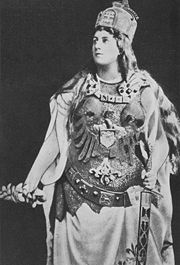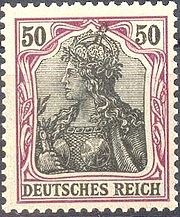
Anna Führing
Encyclopedia


Model (person)
A model , sometimes called a mannequin, is a person who is employed to display, advertise and promote commercial products or to serve as a subject of works of art....
for the Germania stamp of the Reichspost
Reichspost
- Imperial Reichspost :* The Imperial Reichspost was the name of the postal service of the Holy Roman Empire, founded by Franz von Taxis in 1495...
.
Biography
Anna Führing was born in HamburgHamburg
-History:The first historic name for the city was, according to Claudius Ptolemy's reports, Treva.But the city takes its modern name, Hamburg, from the first permanent building on the site, a castle whose construction was ordered by the Emperor Charlemagne in AD 808...
on March 6, 1866 as the daughter of the theatre and restaurant owner Carl Führing. In Berlin she received her education in acting. Frequently she represented on stage the figure of Germania
Germania (personification)
Germania is the personification of the German Nation or the Germans as a whole, most commonly associated with the Romantic Era and the Revolutions of 1848, though the figure was later used by Imperial Germany. She is usually shown wielding the "Reichsschwert" . Additionally, she is sometimes shown...
, as for instance at a festival in Düsseldorf in 1891 when emperor Wilhelm II was in attendance. In 1892, when the Theater am Schiffbauerdamm
Theater am Schiffbauerdamm
The Theater am Schiffbauerdamm is a theatre building at the Schiffbauerdamm riverside in the Mitte district of Berlin, Germany, opened on November 19, 1892. Since 1954 it is home to the Berliner Ensemble theatre company, founded in 1949 by Helene Weigel and Bertolt Brecht.The original name of the...
in Berlin
Berlin
Berlin is the capital city of Germany and is one of the 16 states of Germany. With a population of 3.45 million people, Berlin is Germany's largest city. It is the second most populous city proper and the seventh most populous urban area in the European Union...
was inaugurated, Führing played the role of Iphigenie
Iphigénie
Iphigénie is a dramatic tragedy in five acts written in alexandrine verse by the French playwright Jean Racine. It was first performed in the Orangerie in Versailles on August 18th 1674 as part of the fifth of the royal Divertissements de Versailles of Louis XIV to celebrate the conquest of...
. With the rise of the silent movie
Silent Movie
Silent Movie is a 1976 satirical comedy film co-written, directed by, and starring Mel Brooks, and released by 20th Century Fox on June 17, 1976...
s, Führing took on roles in the new medium.
In 1899, she got married to Ferdinand von Strantz, the Director of the Hofoper of Berlin and by 45 years her senior and then carried the title Baronin Anna von Strantz-Führing; the couple had one daughter. Führing died in Berlin on November 2, 1929.
Movies with Anna Führing
- Hausdame aus bester Familie gesucht (1915, as Anna von Strantz-Führing)
- Ein Held des Unterseebootes (1915, as Anna von Strantz-Führing)
- Nacht und Morgen (1916)
- Das schöne Abenteuer (1924)
- Eine kleine Freundin braucht ein jeder Mann (1927)
- Ossi hat die Hosen an (1928, as Baronin Strantz-Führing)
Literature
- Carl Thinius: Damals in St. Pauli - Lust und Freude in der Vorstadt. Verlag Hans Christians, 1975, ISBN 3-7672-0368-5

